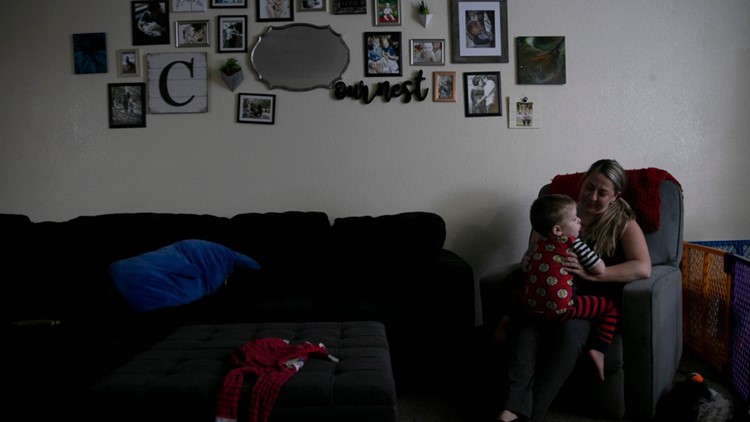SACRAMENTO, Calif — Miranda Griswold and her partner were thrilled to grow their family when they had their first child in 2018. The less thrilling part: adding baby costs to their existing expenses — alimony payments, student loans and credit card bills.
Griswold had a C-section and her doctor recommended she stay at her Merced home for six weeks of recovery time. Her fiancé, who works at a commercial printing press, returned to work after one week of vacation because they couldn’t afford for him to take more time off using family leave, which would replace only 60% of his wages.
“There was no way we could make that percentage work,” said Griswold.
That’s the case for many workers in California. Assemblywoman Lorena Gonzalez, a Democrat from San Diego County, authored a bill this year to increase that percentage — making it more realistic for low-income earners to use the leave that they’re required to fund with 1.2% of every paycheck.
Assembly Bill 123, which the Assembly passed on a 65-0 vote in May and is now in the Senate, would increase the wage replacement rate from at least 60% to 90% of a worker’s highest quarterly earnings in the past 18 months.
“I think it is cruel that… we actually deduct the 1.2% from their paycheck and yet we are dangling something that is unattainable if you can’t afford it,” Gonzalez said in an interview.
Under current law, California’s paid family leave is often being used by those who can more easily afford going without full pay.
Workers making less than $20,000 a year filed nearly 48,000 family leave claims in 2019, only slightly more than the 46,000 filed by those earning $100,000 or more a year, according to the state Employment Development Department. And between 2017 and 2019, the number of claims from the lowest-wage workers declined while claims by workers of every other income group increased, with claims from the highest earners rising most of all, by one-third.
In total in 2019, the state paid nearly $1.1 billion in family leave benefits, including $287 million to those making $100,000 or more a year. The maximum benefit is $1,300 a week, for as long as eight weeks.
Expanding access to leave
AB 123 is the latest in a series of efforts to make paid family leave a more financially realistic option for more employees.
In 2002, California became the first state to adopt a family leave benefit. It was included as an expansion of the state’s disability insurance program, compensating employees who took time off to care for a seriously ill family member or to bond with a new child.
In 2016, then-Assemblymember Jimmy Gomez of Los Angeles authored a bill to increase wage replacements based on income: 70% for those earning below one-third of the state average, and 60% for those who earn more.
In 2019, Gov. Gavin Newsom extended the amount of time employees could take off from six to eight weeks. And last year, he signed a bill authored by Sen. Hannah-Beth Jackson of Santa Barbara, which expanded the law requiring large employers to grant 12 weeks of unpaid leave to any employer with at least five workers.
The wage replacement rates in the 2016 law were due to expire on Jan. 1, 2022. In the budget deal last month between Newsom and the Legislature, the higher rates were extended to Jan. 1, 2023.
The wage replacement of at least 90% was also advocated in a December 2020 report from the California Health and Human Services Agency outlining a revamp of the state’s early learning and child care system.
Jill Thompson, directing attorney of the Audrey Irmas Project for Women and Girls’ Rights at Public Counsel, said she would like to see the higher benefits available for at least the lowest-wage earners.
“I almost feel like low-wage workers are subsidizing the rest of us because they’re paying into the system but not reaping the benefits,” she said.
Now, full-time workers at small businesses making California’s current minimum wage of $13 an hour get $6.24 a week deducted from their paycheck for family leave. Their pay before taxes is $520 a week, which means a weekly benefit of $364 under current law.
“That amount is under the poverty line,” Thompson said. “They’re expected to live under the poverty limit? No wonder people don’t do it. It’s not viable.”
Paid family leave in real life
For Jerry Sandoval, a 36-year old San Diego resident, the 60% wage replacement was not enough. He made about $1,000 a week in 2014 and took paid family leave after the birth of his daughter. But he went back to work after getting his first reduced paycheck.
Sandoval, who now helps advocate for increased wages with the California Work and Family Coalition, recalls his hustle as a new father, working in a hotel by day and a graveyard shift at a casino at night. For a few hours in between, he’d go home to spend time with his baby.
“It’s tough. You don’t realize how hard it is until you go through it,” he said. “I do feel like in the future, if I ever have to use paid leave, I want to be able to take full advantage of it.”
Even for higher wage-earners, the coronavirus pandemic added new layers of financial difficulty to trying to take California’s paid family leave.
Arissa Palmer, 44, of Orange, brought her mother-in-law for a visit from Maryland before the pandemic but she was unable to fly back. She suffers from dementia and needs care 24 hours a day. But with a mortgage to pay and a household to maintain, neither Palmer nor her husband could afford to take leave or hire someone to take care of her.
“We didn’t even know if it was safe to have someone in the home caring for her — and honestly, couldn’t even afford it,” she said.
Palmer switched jobs so she could work from home. She serves as the executive director of BreastfeedLA, which has been advocating for the passage of the bill alongside the Work and Family Coalition.
“Allowing that paid time where parents and the babies can learn to get to know each other and learn each other’s cues is so important,” she said.
Businesses look at the bottom line
The bill does not increase employer contributions; instead, it increases the amount that employees pay into the state family leave fund from each paycheck.
While businesses will adapt and accommodate leaves as needed, the bill may be a bad deal for employees, according to the Central Valley Business Federation.
“In terms of this legislation, it’s a tax increase on everyday Californians, and so many workers in the state of California are having a hard time making ends meet with the cost of things going up,” said Clint Olivier, CEO of the federation, which represents about 70 businesses and associations across five counties, including Chevron and the California Association of Food Banks.
The bill would increase worker contributions by 0.1% to 0.2% per year, which Olivier estimates will be about $300 out of workers’ paychecks by 2025.
“The state says, well, this is such a small amount of money the worker won’t be able to feel it. But the situation on the ground is much different,” Olivier told CalMatters. “It begs the question: Who is in a better place to determine how that money is spent, the individual or the state? And so I believe it’s the individual.”
Miranda Griswold and her partner had their second child in 2019, when they had fewer debts to pay off. Her fiance picked up extra shifts beforehand, so his paychecks would be higher and he could take the full six weeks off.
“We still ended up having to save a ton to make up the difference. Rent is still due, bills are still due,” she said. “On the one hand I almost feel grateful that we got what we did. Having two kids, there’s no way I could have done it by myself.”
“At least California offers this,” she said. “But for a lot of families, it’s still not enough.”
WATCH MORE FROM ABC10: Distance learning proposal, homicide rates | This week in California politics
CalMatters political expert Emily Hoeven talks about an independent study proposal for students not quite ready for in person learning.



